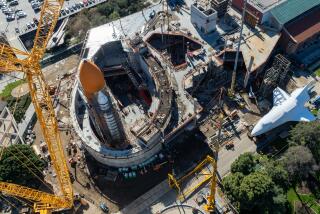Space Shuttle Closing In on Faulty Hubble Telescope : Science: The effort to capture and secure the 25,000-pound observatory is the first major hurdle in the $629-million repair mission.
- Share via
HOUSTON — After three years of recriminations, NASA worked early this morning to come directly to grips with the problems that crippled the Hubble Space Telescope as astronauts aboard the space shuttle Endeavour grappled with the $1.5-billion orbiting observatory.
If all went as planned, astronaut Claude Nicollier was to pluck the 25,000-pound telescope from space with the shuttle’s mechanical arm just after midnight PST and slowly swing it into Endeavour’s payload bay by 2 a.m., so it could be secured to a large turntable for servicing.
Later tonight, Endeavour’s astronauts are scheduled to don $10-million spacesuits, unlimber their micro-gravity wrenches and climb through the air lock for the first of an unprecedented five days of arduous spacewalks.
Working in pairs, they will try to refocus the telescope’s flawed vision and replace its flapping 39-foot solar-power panels. The telescope’s blurred focus has limited its range to objects within 4 billion light-years, instead of the 15 billion light-years designers had promised when it was launched in April, 1990.
If the astronauts are successful, the refurbished telescope could help rewrite the history of the astronomical science.
The rendezvous with the telescope, however, is the highest NASA has ever attempted with one of its shuttles, agency officials said. Endeavour, the space agency’s newest space ferry, can carry only enough fuel for one attempt, and mission officials at the Johnson Space Center were openly jittery about the possibility the shuttle could run out of propellant before completing the mission.
NASA officials, who have endured the recent loss of the Mars Observer space probe, a jammed antenna on the Galileo probe to Jupiter, and increasingly close congressional votes on funding for the space station project, worked hard to play down expectations by emphasizing the complexity of the $629-million repair mission.
“We really are expecting the unexpected at this point,” said Joseph Rothenberg, Hubble program manager at NASA’s Goddard Space Flight Center in Greenbelt, Md.
“If we can’t berth (the telescope) and get it into the payload bay, we won’t even be able to get up to bat, so to speak,” he said. “It would be tragic.”
Late Friday, nearing the end of a five-mile-per-second game of tag 360 miles above the Earth, shuttle commander Richard Covey maneuvered Endeavour to within a few miles of the 43-foot-long telescope with precisely measured bursts from the shuttle’s engines.
Covey, making his first shuttle rendezvous, took manual control of Endeavour as it neared the telescope. He was scheduled to turn the 100-ton shuttle in a slow back-flip in front of the telescope to avoid fouling its delicate instruments with rocket exhaust.
While Covey rationed his fuel, astronomers from Princeton University and Johns Hopkins University on Friday used the space telescope for one last look at a distant quasar before controllers at the Goddard Space Flight Center shuttered Hubble’s single eye and battened down its antennas in anticipation of the rendezvous with Endeavour.
Senior shuttle manager Loren Shriver, who as an astronaut commanded the crew that deployed the telescope 3 1/2 years ago, was one of the last people to see the telescope up close.
He said that he told Endeavour’s crew before they left that they should have no trouble finding the telescope. “I told them: ‘It is a real big telescope. It’s brightly colored in orbit. You shouldn’t miss it,’ ” he said.
“I told them to leave it in better shape than it is now.”
More to Read
Sign up for Essential California
The most important California stories and recommendations in your inbox every morning.
You may occasionally receive promotional content from the Los Angeles Times.













